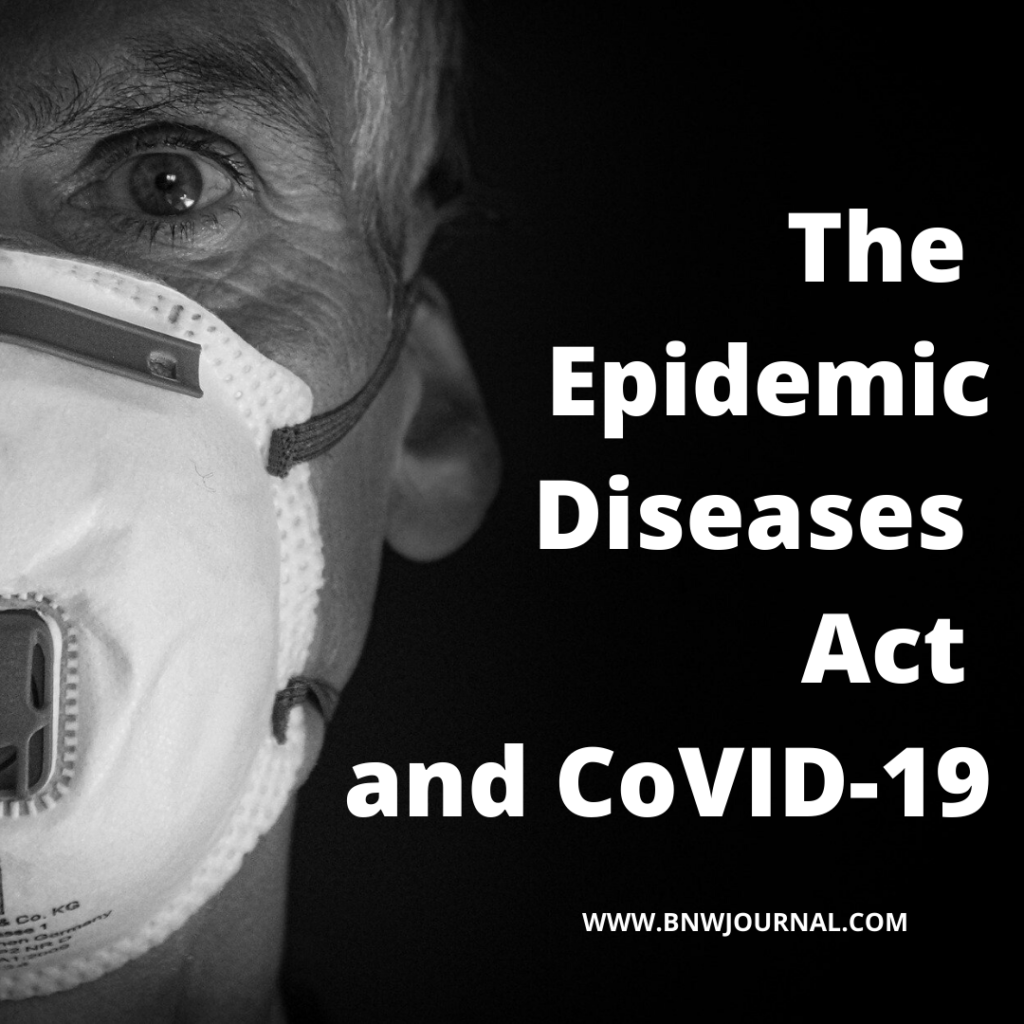![]()
INTRODUCTION
Like almost every country of the world, India is also grappling with the CoVID-19 epidemic. The disease has claimed over 1000 deaths and more than 30000 citizens are affected. The Central Government and the State government are finding every possible way to fight the outbreak. The Central government to fight the CoVID-19 epidemic and to secure its citizens, has implemented The Epidemic Diseases Act, 1897; a 123-year-old law.

ABOUT THE ACT
Historical Background-
The British regime in 1897 enacted this act to tackle the Bubonic Plague (The Bombay Plague) in the then Bombay. The purpose of this Act is to contain dangerous epidemic diseases. This act confers special powers upon the Central or State Governments. It is to implement measures necessary and imminent to control an epidemic.
The Epidemic Diseases Act, 1897 is a colonial-era law, like the Indian Penal Code, 1860; Indian Contract Act, 1872 etc. The Epidemic Diseases Act, despite being a colonial-era law, is relevant in the post-colonial period; though there is no major amendments in act before 2020.
In India, the use of this act is to contain diseases like dengue, malaria, swine flu, cholera. And presently it’s use is to combat the spread of Covid-19. In 2015 the Act was enforced to deal with Dengue and Malaria in Chandigarh. In 2018 enforcement of this act took place Cholera spread in a part of Gujarat.
COVID-19 and Inplementation of Act in India-
The World Health Organization (WHO) declaration of Covid-19 as a global pandemic. There was enforcement of Epidemic Diseases Act throughout the country; after enforcement happened starting the second week of March 2020, to bar the spread of Novel Coronavirus.
This 123-year-old law is one of the shortest laws of India with just four sections.
Section wise explanation of Act
First Section-
Like all other laws of India, the first section describes the title and extent of the act; the very beginning the Act clearly states that it is “An act to provide for the better prevention of the spread of dangerous epidemic disease”.
2nd Section-
The second section explains the special powers. The Act confers on the state government to take special measures and regulations to contain the spread of the disease. Section 2 of the Act states,
“When at anytime the State Government is satisfied that the State or any part thereof is visited by, or threatened with, an outbreak of any dangerous epidemic disease, the State government if it thinks that the ordinary provisions of the law for the time being in force are insufficient for the purpose, may take, or require or empower any person to take, such measures and, by public notice, prescribe such temporary regulations to be observed by the public or person or class of persons as it shall deem necessary to prevent the outbreak of such disease or the spread thereof and may determine in what manner and by whom any expenses incurred (including compensation if any) shall be defrayed”
It further states that the State government takes measures and prescribe regulations for the inspection of people. Specially who travelling via railway or otherwise. It also states about the proper separation of people who are suspects of infection in hospitals. Also about other accommodating facilities like quarantine centres.
Section 2 of the Act provides for and explains the powers of the State government during an epidemic; Section 2A explains the powers of the Central Government during an epidemic.
The powers of the Central and State Government are similar. Just the very basic difference is that-
Section 2 gives powers to the State to enforce this Act in whole or any part of the State; where there is an outbreak of a disease.
While Section 2A provides for a disease outbreak all over India (like Covid-19). And which is not just in the confines of the boundaries of any specific state.
However, there is a special provision in Section 2A. It empowers the Central Government to inspect any ship or vessel arriving or leaving any port of the country. And also to inspect the persons sailing therein.
3rd section-
The Act also has noted punishments for disobedience of any order or regulation under this Act. Section 3 of the Act mentions that any person who disobeys any regulation or order under this Act is committing an offence under Section 188 of the Indian Penal Code, 1860.
4th section-
The frontline workers like the ones of the health department, police department, cleaning services and other emergency services deserve every protection to keep working against the epidemic. Section 4 of the Act ensures protection to persons acting under the said Act. It says that no legal proceeding lie against any person for anything done in good faith or with the intention of doing in good faith under this Act.
The last two sections of the Act are quite narrow in their scope; thus, owing to this drawback and also regarding the changes needed about in other sections of the Act. An Ordinance was promulgated in April 2020 making several changes and additions to this act which shall be discussed further.
THE EPIDEMIC DISEASES (AMENDMENT) ORDINANCE, 2020
Various experts believed that the 123-year-old law needed some changes to make it more effective against the fight for coronavirus. Through this ordinance, a lot of changes were about in the act recently.
Quite surprisingly, violent attacks are increasing against doctors and healthcare workers; thus very urgently the Union cabinet on 22nd April, 2020 promulgated this ordinance. The President has given his assent to the promulgation of the ordinance.
Act of Violence –
The Ordinance makes a lot of changes to the act. Most of these changes relate to the violence that the frontline warriors face. The ordinance thus further defines “Act of violence” in the context of the act. It states that act of violence includes:
- harassment which impacts the living or working condition of a healthcare worker and further preventing him from carrying out his duties. harm, injury,
- Any hurt intimidation or danger to the life of a healthcare service personnel either within the premises of a clinical establishment or elsewhere
- Any kind of obstruction or hindrance that the healthcare workers face in the discharge of their duties either in clinical establishments or elsewhere
- loss or damage to any property or documents in the custody of any healthcare worker are also to be termed as an “Act of Violence”
The ordinance further defines “Healthcare service personnel”. It states that while carrying out his duties relating to the epidemic, the person who comes in direct contact with affected patients and thus is at a risk of exposure to such disease is a Healthcare service personnel.
Healthcare service personnel further includes any public and clinical healthcare provider such as a doctor, nurse, paramedical worker and community health worker, also any other person empowered under the Act to take measures to prevent the outbreak of the disease.
Property as per Act-
The ordinance also defines the word “Property” in the context of the act, which includes:
- A clinical establishment as defined Clinical Establishments Act, 2010
- Any kind of facility which is specified for quarantine or separation or isolation of patients during an epidemic.
- A mobile medical unit
- Any other property which has a direct relation to the epidemic.
Other Chnages-
The ordinance also amends section 2A of the Act which explains the powers of the central government during an epidemic. Earlier in Section 2A, it is mentioned that the central government may inspect only ships or vessels arriving or leaving any port and the persons sailing therein. The ordinance has widened the scope of such inspection by the Central Government and further includes the inspection of any bus, train, goods vehicle, aircraft or aerodrome.
Earlier there is a mention that during this pandemic there are several cases where the members of healthcare services face attacks or harassment via miscreants out of social stigma; and thus obstructing the workers in performing their duties efficiently.
Several states from time to time have enacted various laws to protect the doctors and other healthcare personnel. However Covid-19 outbreak calls for special and unique situations. And the state laws are not stringent enough to deter the mischief caused.
In this context, the most important part of the ordinance makes acts of violence cognizable and non-bailable offences. Whoever commits or abets the commission of violence against a healthcare worker is punishable with imprisonment ranging from 3 months to 5 years and fine ranging from Rs. 50000 to Rs. 2 lakhs.
In case of cause of grievous hurt, the imprisonment is possibly for a minimum period of 6 months and maximum for 7 years with a penalty ranging from 1 lakh to 5 lakhs. Also, the offender shall be liable to pay compensation to the victim and twice the fair market value on any damage of property. Upon failure to pay compensation, such amount is recoverable as an arrear of land revenue under the Revenue Recovery Act, 1890.
CONCLUSION
India is the 2nd largest populous country in the world, with more than 130 crores residing in the nation it is indeed a tough job to handle such an epidemic. We hope that the Central and the State governments working under the Epidemic Diseases Act, 1897 and along with the new ordinance, becomes effective in combating the Covid-19 epidemic. The security of the frontline warriors in this fight against the coronavirus must be ensured.



0 Comments